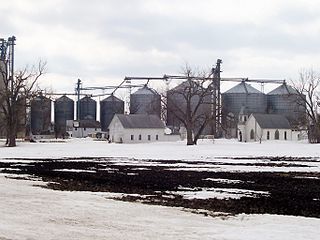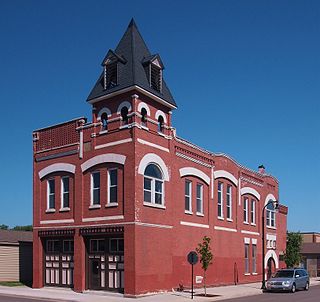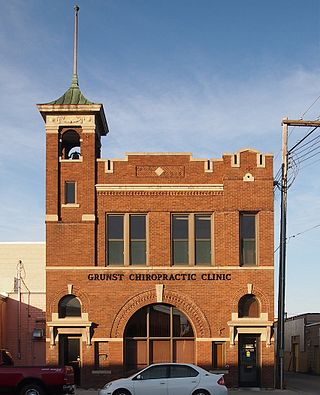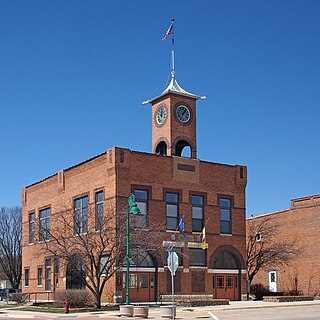
Tenney is an unincorporated community and former city in section 28 of Campbell Township, Wilkin County, Minnesota, United States. A post office was established there in 1887, and Tenney was incorporated as a city on November 30, 1901. The population was five at the 2010 census, tying Tenney with Funkley as Minnesota's least populous community. It is part of the Wahpeton, ND–MN Micropolitan Statistical Area. Tenney's main economic feature is a grain elevator near its southern border.

This is a list of the National Register of Historic Places listings in Rice County, Minnesota. It is intended to be a complete list of the properties and districts on the National Register of Historic Places in Rice County, Minnesota, United States. The locations of National Register properties and districts for which the latitude and longitude coordinates are included below, may be seen in an online map.

This is a list of the National Register of Historic Places listings in Stearns County, Minnesota. It is intended to be a complete list of the properties and districts on the National Register of Historic Places in Stearns County, Minnesota, United States. The locations of National Register properties and districts for which the latitude and longitude coordinates are included below, may be seen in an online map.

The First Congregational Church of Zumbrota is an historic congregational church in Zumbrota, Minnesota, United States. It was built in 1862 in the form of a colonial meeting house. It is listed on the National Register of Historic Places for being one of Southeast Minnesota's oldest standing churches and a reflection of New Englander settlement in many of its towns.

This is a list of the National Register of Historic Places listings in Fillmore County, Minnesota. It is intended to be a complete list of the properties and districts on the National Register of Historic Places in Fillmore County, Minnesota, United States. The locations of National Register properties and districts for which the latitude and longitude coordinates are included below, may be seen in an online map.

This is a list of the National Register of Historic Places listings in Le Sueur County, Minnesota. It is intended to be a complete list of the properties and districts on the National Register of Historic Places in Le Sueur County, Minnesota, United States. The locations of National Register properties and districts for which the latitude and longitude coordinates are included below, may be seen in an online map.

Oliver Green Traphagen was an American architect who designed many notable buildings in Duluth, Minnesota, during the late 19th century and in the Territory of Hawaii during the early 20th century. Among his most famous landmarks are the Oliver G. Traphagen House in Duluth, called the Redstone, and the Moana Hotel in Honolulu, both of which are on the National Register of Historic Places, as are several other buildings he designed.

This is a list of the National Register of Historic Places listings in Steele County, Minnesota. It is intended to be a complete list of the properties and districts on the National Register of Historic Places in Steele County, Minnesota, United States. The locations of National Register properties and districts for which the latitude and longitude coordinates are included below, may be seen in an online map.

Nerstrand City Hall is a historic city hall building in Nerstrand, Minnesota, United States, constructed in 1908. It was listed on the National Register of Historic Places (NRHP) on April 6, 1982, for having local significance in the theme of politics/government. It was nominated for being representative of Nerstrand's early growth, and for being Rice County's best example of municipal buildings of the early 20th century.

Ada Village Hall is the former center for local government in Ada, Minnesota, United States. Completed in 1904, it was also an important public meeting hall and social facility through the 1970s. Architecturally, the building is an excellent example of the combined city hall and fire hall buildings that were constructed in Minnesota during the early 20th century. It was listed on the National Register of Historic Places for having local significance to politics/government and social history.

Grand Mound Town Hall and Waterworks Historic District, also known as Hose house, pump house, is a historic district located in Grand Mound, Iowa, United States. It was listed on the National Register of Historic Places in 2001. The district is composed of two buildings and the town's water tower.

Waverly Village Hall is a municipal event hall in Waverly, Minnesota, United States, built by the Works Progress Administration (WPA) from 1939 to 1940. It was listed on the National Register of Historic Places in 2002 for its local significance in the themes of architecture, entertainment/recreation, and government/politics. It was nominated as a representative of the civic facilities made possible with New Deal federal assistance, as well as for its Moderne architecture and role as a community event space.

The historic Howard Lake City Hall is a multipurpose government building in Howard Lake, Minnesota, United States, built in 1904. It originally housed the city's government offices, post office, public library, fire department, and public meeting hall. In the 1930s the city began operating a municipal liquor store in the building, which remains the building's primary use today as most other functions have moved to newer facilities. The Howard Lake City Hall was listed on the National Register of Historic Places in 1979 for having local significance in the themes of architecture and politics/government. It was nominated as an example of early-20th-century small-town government architecture, and as Howard Lake's most prominent building.

The original Delano Village Hall is a historic government building in Delano, Minnesota, United States, now in development as the Delano Heritage Center. From its construction in 1888 through most of the 20th century the building housed municipal offices, the police and fire departments, and a public library, while the upper-floor meeting hall was a key venue for public and private events. It was listed on the National Register of Historic Places in 1979 for having local significance in the themes of architecture and politics/government. It was nominated for being a typical example of Minnesota's municipal buildings of the late 19th and early 20th century, and for its longstanding centrality to government and civic functions in Delano.

The former Wadena Fire and City Hall is a historic government building in Wadena, Minnesota, United States, built in 1912. It was listed on the National Register of Historic Places in 1989 for having local significance in the theme of politics/government. It was nominated for being a representative example of early-20th-century civic development and of the municipal buildings common to many small Minnesotan cities. The building now houses a chiropractic clinic.

Ironton City Hall is a historic municipal building in Ironton, Minnesota, United States. It was built in 1917 to house the city's offices, fire department, library, jail, and an auditorium that hosted numerous community organizations and events. Ironton City Hall was listed on the National Register of Historic Places in 2002 for having local significance in the themes of politics/government and social history. It was nominated for being the longstanding focal point of Ironton's government services and community activities.

The Grey Eagle Village Hall is a multipurpose municipal building in Grey Eagle, Minnesota, United States. It was built in 1934 as a federally funded New Deal project to create jobs during the Great Depression. It originally contained local government offices, a fire station, and a community auditorium. The building was listed on the National Register of Historic Places in 1985 for having local significance in the themes of architecture and politics/government. It was nominated for being a superlative example of the public works projects of the Civil Works Administration.

The Sauk City Fire Station, begun in 1862, housed the city's early fire department, and served as a center of the community. Today it is one of the oldest fire stations in Wisconsin. It looks much like it did in 1870 - a gable-roofed building with a hose-drying tower. It was added to the National Register of Historic Places in 1999.

The Pine Island City Hall and Fire Station, at Main and 3rd Streets in Pine Island, Minnesota, United States, also known as the Pine Island City Hall, was built in 1909. It was listed on the National Register of Historic Places in 1980.
























